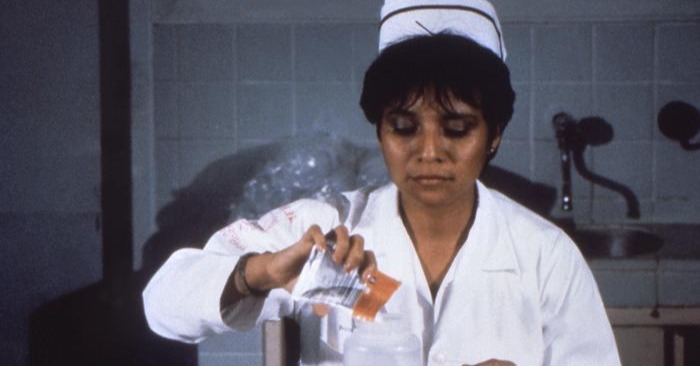
What Does a Family Nurse Practitioner Do?
Family nurse practitioners perform most of the same tasks as [...]
Medical science discovered the anesthetic properties of nitrous oxide, ether, and chloroform in the 1840s, giving birth to the modern practice of anesthesiology. The first professionals in the United States to administer these pain suppressants weren’t doctors; however, they were nurses, administering needed relief to soldier-patients during the Civil War.
Today, some nurses—known as certified registered nurse anesthetists or CRNAs—still specialize in anesthesiology. You’ll find these advanced practice registered nurses working in every practice setting and participating in all types of surgical procedures. A certified registered nurse anesthetist may even be the sole anesthesia provider for an entire hospital, and CRNAs remain the primary anesthetists for the US Armed Forces.
Becoming a nurse anesthetist requires step-by-step advancement. CRNAs begin their careers as critical care nurses and then complete several additional years of schooling. The educational commitment to become a nurse anesthetist is intense; not only are CRNAs responsible for administering potentially dangerous anesthetics, but they also frequently work autonomously. There’s also a lot of variety to their work, so they need to remain on their toes.
“Every patient is unique, and the procedures and anesthesia required are different,” Andy Johnson, MS, CRNA, who works in Olivia, Minnesota tells the American Association of Nurse Anesthetists on its Future of Anesthesia Care Today website. “Being the sole anesthesia provider at my facility, I am capable of handling everything from the intubation of a patient with a difficult airway to the anesthesia care for a scheduled cesarean section.” Nurse anesthetists shoulder a lot of responsibility.
In this article, we’ll cover:
Most people are familiar with Florence Nightingale‘s work during the Crimean War and her efforts to lay the foundation of modern nursing. Around the same time, anesthetics came into widespread use.
Early anesthesiology developed through trial-and-error. Monitors and other modern equipment didn’t exist, so keeping people sedated without killing them was mostly a matter of observing breathing patterns and the patient’s color while monitoring their pulse with a finger. This task fell to nurses; surgeons regarded them as more reliable stewards of patients’ health than medical residents, who were more likely to be observing the surgery than monitoring the patient’s condition.
Nurse anesthetists took their jobs seriously. Nurse Alice Magaw, who practiced in the late 1800s, was the first nurse anesthetist to publish a scientific article for the Lancet. Her innovations led to major advances in surgery and anesthesia. She administered anesthetics for 14,000 procedures without a single anesthesia-related death, earning her the moniker “the Mother of Anesthesia,” and helping to establish the practice of anesthesia by nurses.
The first educational program for nurse anesthesiologists commenced in 1909. This program, a six-month training covered anatomy, physiology, and the pharmacology of anesthetics was created by Agnes McGee. It may have been the inspiration for the many nurse-led anesthesia schools that opened between 1912 and 1920—many years before the first MD anesthesia program was created.
When you become a nurse anesthetist, your role in patient care will typically extend from pre-op through post-op, though some CRNAs take part in non-surgical diagnostic, obstetrical, and therapeutic procedures as well.
The day-to-day responsibilities of nurse anesthetists can include:
Certified registered nurse anesthetists work in settings like:
Sometimes, CRNAs work on anesthesiology teams alongside doctors. In rural and underserved urban areas of the US, however, nurse anesthetists are frequently the principal anesthesia providers for hospitals and medical practices. That’s because employing a nurse is less expensive than hiring a doctor. Rochester, Minnesota; Mobile, Alabama; and Charleston, West Virginia have the highest concentration of nurse anesthetists.
Both nurse anesthetists and MDs who specialize in anesthesiology are trained to administer anesthesia safely and effectively. Interestingly, when a CRNA administers anesthesia, the work they’re doing is categorized as nursing. When an anesthesiologist administers the same drugs in the same setting, they’re practicing medicine.
The biggest difference between CRNAs and anesthesiologists is that anesthesiologists complete medical school and can work independently in all states. In contrast, only some states allow registered nurse anesthetists to work autonomously. In others, a registered nurse anesthetist must work under the supervision of a board-certified MD.
The states in which nurse anesthetists may work independently are:
In some areas where supervision is required, it’s a formality. “The physicians never ‘supervised’ the CRNAs in the sense of telling us how to provide anesthesia, but relied on our education and training to determine the best anesthetic plan,” Dennis Gundersen, CRNA, explains on the Future of Anesthesia Care Today website. “We would discuss the surgeons’ needs for a particular case and then develop the anesthesia plan… In the seven years I practiced at this hospital when seeking anesthesia consultation, I consulted other CRNAs; the closest anesthesiologist was an hour away.”
Becoming a certified registered nurse anesthetist typically takes seven or more years of education and experience in critical care nursing, including 2,500+ clinical hours. In the past, nurses who dreamed of working as anesthetists would complete a two-year graduate program approved by the Council on Accreditation of Nurse Anesthesia Educational Programs before taking the certification exam offered by the National Board of Certification and Recertification for Nurse Anesthetists (NBCRNA). As of 2022, however, master’s programs for nurse anesthetists will no longer be offered and becoming a registered nurse anesthetist will require completing a doctorate-level program.
Before you can apply to a DNAP (doctorate of nursing anesthesia practice) or DNP (doctorate of nursing practice) degree program, you’ll need to do the following:
Getting your bachelor of science in nursing (BSN) from an American Association of Colleges of Nursing (AACN) or National League for Nursing(NLN) accredited university will prepare you to work as a registered nurse. You’ll take courses in anatomy, physiology, health assessment, pathophysiology, public health, nutrition, and emergency care during a typical four-year bachelor’s degree program in nursing.
If you’ve already earned an associate’s degree in nursing (ADN) and have experience working as a registered nurse, there are on-campus and online RN to BSN programs that take just one or two years to complete.
Check out the RN to BSN programs at:
There are also accredited accelerated BSN programs at many universities for students who have already earned a bachelor’s degree in another field and want to transition to nursing. There are well-ranked one and two year on-campus and online nursing degree programs at:
Licensing requirements for nurses vary from state to state, but typically you’ll need to pass the National Council Licensure Examination for Registered Nurses (NCLEX-RN) exam. Passing this exam, which is administered by the National Council of State Boards of Nursing (NCSBN), demonstrates that you have the minimum nursing skills and knowledge required to care for patients safely. You’ll also have to provide transcripts showing that you’ve earned your ADN, BSN, or degree from a hospital-based nursing school.
Whether you’re applying to master’s degree-level nurse anesthesia programs or planning to apply to DNAP or DNP programs, you’ll need to work for at least a year in a clinical setting like the ER, a cardiac care unit, or ICU. During this time, it’s a good idea to pursue a Critical Care Registered Nurse Certification, because having this certification will make you a more attractive candidate when you’re applying to doctoral programs.
As of 2018, there were 121 accredited nurse anesthesia programs—16 of which awarded a doctoral degree. That will change soon. All master’s degree-level nurse anesthesia programs will have to transition to doctorate programs by 2022 or lose accreditation, and many schools have already transitioned their master’s programs into doctoral programs. The Council on Accreditation of Nurse Anesthesia Educational Programs (COA) has an up-to-date list of all accredited nurse anesthesia programs in the US—most of which take about three years to complete.
You might want to check out the DNAP programs at:
Be aware that admission to both MSN/MSNA and DNP/DNAP programs is highly competitive. Every school will have its criteria for admission, but it’s not unusual for applicants to have to meet the following standards:
It’s a good idea to look at the admission requirements for DNAP and DNP programs even if you still haven’t chosen a BSN program. Armed with this knowledge, you can take care of core coursework, connect with mentors who can guide you through the process of becoming a nurse anesthetist, and find shadowing opportunities. How will you find those opportunities? Don’t discount the value of the old-fashioned cold call.
That’s how Ryan Pettit, DNP, CRNA, found a way into the OR after working in real estate development.
“I messaged a total stranger on social media named Ty Huff, CRNA, and asked if I could shadow him,” he explains in an AANA profile. “I’ll never forget that day in the operating room because it was a life-changing experience for me. I was totally enamored by his ability to put people to sleep, take away their pain, and wake them up like nothing had ever happened. I could tell Ty genuinely loved his job and found both satisfaction and fulfillment in it.”
The existence of two degree paths for CRNAs is understandably a source of some confusion. The DNP is the more common degree, but both of these nursing degrees are classified as practice-oriented degrees or clinical doctorates (as opposed to research degrees like the Ph.D. in Nursing or the Doctor of Nursing Science degree). Students in both programs take courses in anesthesia biology, anesthesia pathophysiology, anesthesia pharmacology, obstetric anesthesia, geriatric anesthesia, and pain management. Depending on the school, CRNA students will choose sub-specialties like pediatrics, obstetrics, cardiovascular anesthesiology, neurological anesthesiology, or dental.
The biggest differences between DNP and DNAP programs can be summarized as follows:
-The DNAP is the only degree specially designed for nurse anesthetist students
-DNP programs are only offered by nursing schools
-Most nurse anesthetist programs are not located within schools of nursing
-DNP programs are accredited by the American Nurses Credentialing Center
-DNAP programs are accredited by COA
-DNAP students are required to complete a capstone project
Choosing between the two degrees may be a matter of whether the schools you’re most interested in offer a DNP with an anesthesiology specialty or a DNAP, and whether you feel it’s important to attend a program that is approved by the COA. Regardless of which path you choose, you should look for schools that partner with research and teaching hospitals, offer opportunities for experience-based learning and research, and have mentorship programs.
In addition to being licensed, registered nurse anesthetists must also be certified by the NBCRNA and then recertified on a regular schedule. The certification process involves submitting a valid RN license, proof of 40 hours of continuing education, verification of work in anesthesiology during the prior two years, and verification of good mental and physical health.
In the past, CRNAs would simply recertify after a period of two years, but now the NBCRNA offers a Continued Professional Certification (CPC) Program in place of the former recertification program. Nurses still check in every two years, but they also complete specific continuing education requirements.
If the above educational commitment seems extreme, keep in mind that certified registered nurse anesthetists work in a highly demanding field and are paid accordingly. CRNA is the highest-paying nursing career, according to Nurse.org.
The Bureau of Labor Statistics reports that nurse anesthetists earn about $167,950 per year—especially in places like Wyoming, Montana, and California where wages are highest. Maybe that’s why registered nurse anesthetist has made the list of CNN’s 100 Best Jobs in America. The BLS also reports that there’s a growing demand for CRNAs, so it’s likely that you won’t have trouble finding a job once you’ve racked up the required years of schooling and experience.
So, is this the right career for you? Only you can answer that question. But if you’re looking for a job in medicine that will pay well and never get boring, this might just be it.
(Last Updated on February 26, 2024)
Questions or feedback? Email editor@noodle.com

Family nurse practitioners perform most of the same tasks as [...]

Education requirements for nurses in the U.S. are becoming more [...]

A Doctor of Nursing Practice (DNP) degree qualifies you for [...]

The Doctor of Nursing Practice (DNP) is a terminal practice-level [...]
Categorized as: Advanced Practice Nursing, Nursing & Healthcare